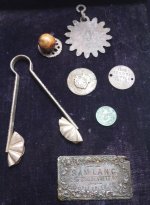Dougie Webb
Sr. Member
- Jun 14, 2019
- 399
- 692
- Detector(s) used
-
Fisher F5
Garrett Ace 200
- Primary Interest:
- Metal Detecting
Earlier today, I found some chunks of metal that looks like slag (I find a LOT of slag!). However, it has an extremely high specific gravity - around 10.5 (which is real close to silver), BUT the SG of lead is about 11.5 - and it seems WAY more likely that somebody let a couple of chunks of lead fall off the wagon rather than silver. My scale is pretty precise - but still...silver?! I don't know...
I read that silver has a pretty high thermal conductivity and that it melts an ice cube faster than most metals. Its conductivity is about 420 at room temperature, compared to about 35 for lead. I didn't have a piece of lead to test against, but I do have iron (75) and aluminum (240). The hunk of metal I found consistently melted the same size ice cube faster than both the Fe and Al. Not surprisingly, it melted way, way faster than the iron.
Now here's the thing. I can't *imagine* it's actually silver. But if it's lead (which is the only other thing that's even near as dense), then how the heck did it melt ice so much faster than iron, which has better thermal conductivity (not to mention aluminum)?
Any scientists out there? I guess my main question is this: Am I understanding thermal conductivity correctly?
Thanks in advance!
PS - The chunk of metal polished up real nice, but tarnished in bleach.
I read that silver has a pretty high thermal conductivity and that it melts an ice cube faster than most metals. Its conductivity is about 420 at room temperature, compared to about 35 for lead. I didn't have a piece of lead to test against, but I do have iron (75) and aluminum (240). The hunk of metal I found consistently melted the same size ice cube faster than both the Fe and Al. Not surprisingly, it melted way, way faster than the iron.
Now here's the thing. I can't *imagine* it's actually silver. But if it's lead (which is the only other thing that's even near as dense), then how the heck did it melt ice so much faster than iron, which has better thermal conductivity (not to mention aluminum)?
Any scientists out there? I guess my main question is this: Am I understanding thermal conductivity correctly?
Thanks in advance!
PS - The chunk of metal polished up real nice, but tarnished in bleach.






